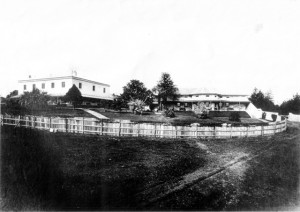Callan Park was initially a combination of purchases by Crown Solicitor and Police Magistrate John Ryan Brenan. In 1839 he bought what he then named the Garry Owen Estate.
Brenan’s residence, Garry Owen House, built c1840 and possibly designed by Colonial Architect Mortimer Lewis, was on an elevation overlooking the Parramatta River, with a tree lined avenue (part of which survives) from wrought iron gates on Balmain Road through spacious gardens.
For many years the house was the Nurses Training School for Callan Park (later Rozelle) Hospital. Today the Greek Revival style house is the home of the NSW Writers’ Centre.

Tag Archives: Rozelle Hospital
Pictures of the week 7 & 8
Completed in 1885 by Colonial Architect James Barnett in cooperation with Dr Frederick N. Manning, Inspector for the Insane, some twenty neo-classical buildings were constructed and named the Kirkbride Block on the former Garry Owen estate after the U.S. psychiatrist Dr Thomas Kirkbride. Kirkbride advocated the importance of natural surroundings in the treatment of mental illness, and essential to the Callan Park plan were the extensive parklands designed by the Director of the Botanic Gardens Charles Moore.
Patients occupied the buildings until 1994 when they were handed over to Sydney University who moved their Sydney College of the Arts from Reynolds Street Balmain to the site in 1996. More on the Kirkbride model of treatment in an international context can be found here: http://www.kirkbridebuildings.com
Images – photographer Richard Hughes
Callan Park and Broughton Hall: An Urban Haven
Compilation of a factual history of the Rozelle Hospital site and the evolution of its architecture has become urgent. The hospital had a continuous 160-year history of providing care for the community’s mentally ill, before closing its doors at the end of April, with all patients being transferred to Concord Hospital.
The site is an integral part of Leichhardt’s evolving built environment but the demolition of 117 of its current 176 buildings is proposed. Although necessary research on Callan Park’s grand stone buildings is largely complete, together with that on former estates, Garry Owen and Broughton Hall, the significance of the newer brick buildings on the site is often overlooked.
At the time, the hospital buildings of the 1950s and 1960s were regarded as innovative and long overdue. They are a visible statement about removing the social stigma previously attached to mental illness, together with the custodial (“asylum”) approach to its care and treatment. Although these newer buildings lack the charm and grandeur of the older hospital buildings, their functional design and brick construction symbolize an era of mental health reform: Callan Park’s high surrounding brick wall fell as these modern buildings rose.
“These buildings represent pivotal change in the history of public health care” architectural historian and editor of the Leichhardt Historical Journal Peter Reynolds said. Leichhardt Historical Journal, an independent journal that has published local history since 1971, is to produce a book titled Callan Park and Broughton Hall: An Urban Haven which will record all buildings on the former hospital site. “The Journal’s acquisition of original plans of these buildings will add enormous value to the book and should help the site’s long term conservation” he added.
Peter Reynolds is collaborating with architect Ken Leong on the book; Leong’s thesis Rozelle Hospital (1819-1984) its origins and development: the amalgamation of Callan Park Mental Hospital & Broughton Hall Psychiatric Clinic was completed in 1984 for the degree of Bachelor of Architecture at UNSW. For more information on the project contact: John Williams on email bhopal@sydney.net or visit www.lhj.org.au
Images
– Rozelle Hospital, ca 1900
– Aerial view of Callan Park and Rozelle Hospital, 2003




